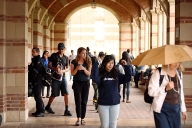You have /5 articles left.
Sign up for a free account or log in.
.jpg?itok=sqnN-ZmH)
Enrollment is declining at University of Maine system campuses but on the rise at community colleges in the state.
Maine community colleges are experiencing an enrollment boost after launching a temporary free college program this past fall, designed to attract high school graduates affected by the pandemic. The University of Maine system, however, is simultaneously wrestling with enrollment losses.
Some university system leaders and faculty members say the lure of free college—while positive—is partly to blame for the decline in students, and they hope state lawmakers will help them institute their own systemwide college affordability program to attract low-income students. Community college system leaders support making the four-year institutions more affordable, but they say free community college isn’t the reason for enrollment declines at the system’s universities.
The free college program, originally proposed by Maine governor Janet Mills, covers two years of tuition for new and returning students who graduated or are scheduled to graduate high school from 2020 through 2023. Enrollment across the community college system rose 12 percent in fall 2022, returning to pre-pandemic levels of 16,791 students after staggering declines.
The program has been “a success at really encouraging students who stepped away from the higher education pathway during the pandemic to reconsider and come back into higher ed,” said David Daigler, president of the community college system.
Meanwhile, undergraduate enrollment across the University of Maine system fell about 5 percent over the same period, a loss of slightly over 1,200 students, which has contributed to budget problems and belt-tightening measures. The system’s Board of Trustees voted to use reserves and COVID-19 relief dollars and institute hiring freezes last November to address a $5 million budget deficit across the system, The Portland Press Herald reported. The University of Maine at Farmington also laid off nine full-time faculty members last year.
Dannel Malloy, chancellor of the University of Maine system, said he supports the free college program, but it’s hard to compete with the simplicity and allure of the word “free.” The number of students who were admitted to a University of Maine system campus but subsequently decided to attend a community college rose 79 percent this year compared to last year, from 273 to 489 students, according to data from the university system. He emphasized that it’s still a “relatively small” group, but the increase suggests growing interest in more affordable higher ed options among their applicants.
The crux of the enrollment problem is Maine is the “oldest state in the nation” in terms of its population, “and for a long period of time, students graduating from high school [have] been a declining population,” he said.
Malloy noted that system leaders are focused on updating dorms to attract more students and “rightsizing [the] employee base to reflect the current population as opposed to the population that might have existed 10 or 20 years ago.” The system is also working on a strategic plan that would double online offerings in hopes of drawing learners who stopped out of college.
“We want a strong community college system” and a strong transfer pipeline to the university system, he said of the free college program. “But we also want to make sure that our students are given the same opportunities.”
State Senator Mike Tipping originally proposed a bill in February that would waive half of the tuition at University of Maine system campuses for up to four years for students scheduled to graduate high school in 2023, 2024 or 2025 and half of tuition for up to one year for returning students living in the state for at least five years who are no more than 30 credits away from finishing their degrees. A draft of the bill has since been amended and now proposes expanding a pre-existing program in the system that covers any remaining tuition after grants and scholarships for students who receive the Pell Grant, federal financial aid for low-income students. The program currently is available at four universities and would be extended systemwide.
Samantha Warren, the system’s director of government and community relations, said she believes there’s “strong support for expanding investment to ensure that tuition at Maine’s public universities continues to be affordable and accessible to all Maine students.”
“I think there is certainly a recognition that the last-dollar community college program really increased their enrollment and that it’s important for Maine students to have choice, and for many Maine students that choice may be Maine’s public universities,” she said. “Building on the early success of free community college and recognizing the importance of providing Maine students equitable access to public higher education in the state, we’re very hopeful that this will move forward.”
Daigler doesn’t believe the free college program is to blame for the enrollment challenges at the state system’s universities, though he’s in favor of financial support for students who want to attend system campuses.
Of the 5,574 students who enrolled through the program in fall 2022, 1,232 of them were new, first-time community college students; 749 were students who graduated high school in 2020 and 2021 but hadn’t enrolled anywhere until then, according to data from the community college system.
“I’ve talked to those students, and they had the benefit of being out in the real world and said, ‘I need to get an education to get ahead and free college is my ticket,’” he said. “And they wouldn’t have been able to attend without the free college program.”
The percentage of Maine high school graduates going to college has declined over the years, from 63 percent in 2015 to 54 percent in 2021, according to National Student Clearinghouse Research Center data.
Daigler believes students who took advantage of the free college program made “a price-based decision” about college and likely would have chosen community college over a four-year university anyway. He also noted that community colleges attracted about a quarter of Maine high school graduates before the pandemic and continue to do so now.
It’s a “natural narrative” that community colleges are enrolling would-be university students, given the contrasting trends, but he doesn’t believe it holds up “when you begin to dig into the numbers and what’s been happening.”
The state Legislature is currently considering extending the free college program to high school students graduating in 2024 and 2025. Daigler hopes the program is eventually made permanent, but he also supports efforts to make university offerings more affordable.
“Lowering the barriers to education in all categories … is of value,” he said. “I would encourage the state to consider making that investment.”
A group of economics professors at Maine universities wrote an open letter in support of Tipping’s proposal. They expressed support for the free community college program but argued that “without an accompanying policy reducing the cost of attending a school within the University of Maine System, this policy is likely to have a destabilizing effect on the system of public higher education in Maine and on students themselves.”
Lisa Botshon, an English professor at the University of Maine at Augusta, said faculty members are feeling the pressure of enrollment declines. She highlighted the faculty layoffs at University of Maine at Farmington as an example.
“They lost historians and philosophers,” she said. “They lost this kind of core group of faculty that were invested in humanities and social sciences.”
She sees the layoffs as a loss for the university’s future students.
“Quite frankly … a big part of this problem is just the substantial decrease in funding for public higher ed in general,” she added. The result is “pitting institutions against each other,” which is “really self-destructive … We need more public funding all around.”
Maine isn’t the only state where some professors feel college affordability programs have shaken up the public higher education ecosystem. Audrey Fisch, an English professor at New Jersey City University, highlighted the Garden State Guarantee, introduced by New Jersey governor Phil Murphy in 2021, which covers tuition for New Jersey students with household incomes of $65,000 or below at state public universities for their third and fourth years.
She believes the program makes more expensive public universities a better deal for low-income students and draws them away from universities that have traditionally served them, such as hers. She partly blames the program for continued enrollment declines at her university and the cutting of at least 30 full-time faculty members last December.
“We very much have a system in which the universities are competing against each other for enrollment … We’re very much tuition-dependent,” she said. “Not all students are as portable, so the students who remain at New Jersey City University … are suffering the fact that the institution has fewer and fewer resources to support those students. This is both a local issue and a national issue in terms of this phenomenon.”
Ryan Morgan, CEO of the Campaign for Free College Tuition, an organization that advocates for free college programs, said while “there may be a drop in enrollment at the four-year schools … there’s a net increase in enrollment over all. From our perspective, as long as access is increasing, we’re happy.”
He also noted that in Tennessee, more than 31,000 students earned a credential through the state’s free tuition program, and half of those students transferred to a public four-year university, so universities may benefit from a boost in transfer students down the line.
Daigler said the community college and university systems in Maine “work together very closely.” At the same time, some degree of competition is “healthy.”
“In general, the student who wants to go to college has a lot of options and there’s competition,” he said. “I think some level of that makes us all better. It keeps us on our game.”


.png)






